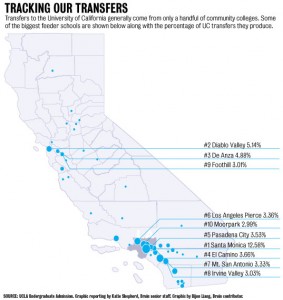Sabrina Adams has an auditory learning disability, meaning sometimes it takes her longer to take in and process a lecture. Taking notes and listening at the same time can be a challenge.
But when she came to UCLA as a third-year sociology transfer student this fall, she wasn’t aware of the resources available to her, such as a student note-taking service that could help her with her learning disability. If these kinds of resources were made more visible to transfer students, Adams wouldn’t have had to navigate the process on her own.
Her problem is not unheard of – many transfer students believe access to UCLA’s transfer student services is lacking.
Frequent complaints about the lack of transfer-specific resources show that there are greater priorities in need of attention before taking on the enrollment challenge presented at the UC Board of Regents meeting last week.
At the UC Regents meeting, a group of UC administrators presented the Transfer Action Team Report, outlining initiatives the UC should make to improve its partnership with the California Community Colleges and help in providing higher education to a larger audience of transfer students.
The report called for a greater presence of the UC on the campuses of the California Community Colleges and an increased focus on the streamlining of transfer students to the UC, though these goals seem premature for UCLA.
UCLA needs to provide its current transfer students, who make up 30 percent of the undergraduate student body, with the infrastructure necessary to access the resources they need before attempting to tackle the larger goals presented in the report.
Randall Call, a fourth-year sociology student and member of the Transfer Student Task Force at UCLA, a collection of transfer students aimed at promoting the needs of transfer students, said he thinks the limited staff working directly for transfer students blocks students from accessing available resources.
The Bruin Resource Center currently only has one staff member, Vanessa Luke, the program developer of the Bruin Transfer Program, working specifically on transfer issues. She is currently on leave.
Andrew McClure, an assistant director of the Bruin Resource Center, is stepping in for Luke, but transfer student concerns could fall through the cracks while the center tries to fill in the staffing gap.
Transfers including Adams, Call and Rick Matsumoto, a third-year business economics transfer student, said many transfers relied on Luke as a go-to person for support and information about things like signing up for classes.
Though it’s great to hear about vital staff members like Luke who work toward furthering the success of transfer students, she shouldn’t be the only administrative contact for a huge portion of the undergraduate population.
Using insight from current transfer students on the Transfer Student Task Force, the administration can create tangible change by addressing and fixing the lack of personnel dedicated to transfer needs.
Paolo Velasco, interim director of the Bruin Resource Center, said himself that the Bruin Resource Center is not a full-fledged transfer center. Many other UCs have centers that specifically handle the needs of transfer students, unlike the center at UCLA, which serves various student populations.
Velasco makes the important point that many of the populations being served through the Bruin Resource Center, such as veterans and parenting students, are often transfers too, but this doesn’t mean the center is transfer exclusive.
UC Riverside and UC Santa Barbara are listed as the only UCs in the UC Regents report lacking a “dedicated space for matriculated transfer students,” despite the fact that UCLA doesn’t have a transfer-exclusive center either. Trying to pass off UCLA’s center for something it is not is not productive in serving the needs of these students.
Even with this disconnect between the center the report claims we have and the reality of the Bruin Resource center, there has been little administrative effort beyond conversation to expand transfer resources.
Increasing staff support for transfers will allow the already supportive Bruin Resource Center to become an even better resource on campus and a point of pride for UCLA.
The UC Regents meeting emphasized the need to strengthen UC partnerships with community colleges, and it would be in UCLA’s interest to increase visibility of transfer support programs that cater to transfer students’ needs if we want to advocate for these partnerships in the long run.
If this process doesn’t start now, tackling loftier goals presented in the report, such as “to recommit UC to enrolling at least 33 percent transfers systemwide and by campus,” will be tougher in the future, especially considering the lack of institutional staff to support the potentially growing transfer population.
In order for UCLA to have a shot at developing the role of the UC as a provider of higher education for transfer students across California, simple issues like understaffing need to be dealt with now.
Email McCarthy at jmccarthy@media.ucla.edu. Send general comments to opinion@media.ucla.edu or tweet us @DBOpinion.

